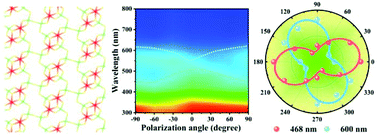2D ternary vanadium phosphorous chalcogenide with strong in-plane optical anisotropy†
Abstract
Low-symmetry 2D materials are reviving recently owing to their azimuth-angle-dependent physical properties, which can be applied in polarization-sensitive optical and photoelectric devices. In this work, layered V2P4S13 with a novel low-symmetry porous structure was introduced as a promising highly anisotropic 2D material. We systematically investigated the structural, phonon-vibrational, and optical properties of 2D V2P4S13 by transmission electron microscopy, angle-resolved polarized Raman spectroscopy, angle-resolved reflection, and absorption spectroscopy. We discovered that 2D V2P4S13 shows strong crystallographic anisotropy, highly porous structure, and unique bi-vanadium atom coupling in the 2D plane. Polarized Raman spectroscopy indicated the strong phonon vibration anisotropy of 2D V2P4S13. Additionally, angle-resolved difference reflection and absorption spectra demonstrated optical anisotropy with a high anisotropic absorption ratio of 1.55 at 468 nm. Remarkably, we discovered unusual linear dichroism conversion of V2P4S13 from 468 nm to 600 nm. Such unique structural features of 2D V2P4S13, in combination with high optical anisotropy, make it an ideal platform for novel polarization-sensitive devices.



 Please wait while we load your content...
Please wait while we load your content...